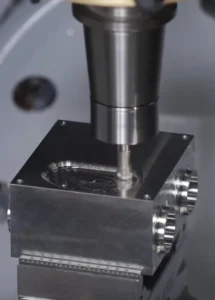When someone hears “5-axis CNC,” they often imagine an advanced, futuristic machine. In reality, it’s simply a milling system that moves a cutting tool or part in five different directions.
Linear Axes (X, Y, Z)
Every CNC machine begins with three basic movements, also known as the linear axes:
- X-axis: moves left to right
- Y-axis: moves front to back
- Z-axis: moves up and down
Think of this like drawing on paper. The X and Y axes let you sketch horizontally and vertically, while the Z axis lifts or lowers the pencil. Together, they create the foundation of traditional 3-axis machining.
Example: Drilling a set of holes into a flat aluminum plate only requires these three axes. The tool moves across the plate (X and Y), plunges down (Z), and repeats. This approach works well for flat or prismatic parts, but it struggles with curves or undercuts.
Rotary Axes (A, B, C)
The real leap in capability comes from the rotary axes, which allow rotation around the linear axes:
- A-axis: rotation around X
- B-axis: rotation around Y
- C-axis: rotation around Z
Most 5-axis machines don’t use all three at once. Instead, they combine linear motion with two rotary axes, depending on the machine design.
Coordinated Use of All Five Axes
The power of 5-axis machining comes from synchronizing all five movements. This enables more efficient production of intricate shapes and designs.
Advantages:
- Multi-face machining in one setup – Parts that once required five or six clampings can now be completed without moving them.
- Improved surface finish – The tool stays aligned with curved surfaces, reducing step marks and polishing needs.
- Higher accuracy – Eliminates errors caused by repeated setups.
- Time savings – Fewer interruptions mean faster cycle times.
Machine Configurations in 5-Axis CNC
Not every 5-axis machine is built the same. Different configurations fit different industries and part sizes:
- Table/Table (Trunnion systems)
The component is mounted on an adjustable rotating platform that can tilt. This setup is compact and stable, making it ideal for small-to-medium parts such as orthopedic implants or aerospace brackets. - Head/Table
The table rotates as the spindle head tilts. This design balances flexibility with rigidity and is a popular choice for job shops that handle varied work. - Head/Head (Dual Swing Head)
The two rotational axes are integrated directly into the spindle assembly. This configuration suits very large or heavy parts like automotive molds or engine housings, where moving the part itself isn’t practical.
Quick Reference: Axis Movements
Here’s a summary table to help keep the axes straight:
| Axis | Movement Type | Description |
| X | Linear | Moves tool/part left–right |
| Y | Linear | Moves tool/part front–back |
| Z | Linear | Moves tool/part up–down |
| A | Rotary | Rotates around X-axis (tilt) |
| B | Rotary | Rotates around Y-axis (tilt) |
| C | Rotary | Rotates around Z-axis (rotation) |
Think of the three linear axes as the box you’re working with, and the rotary axes as the ability to spin or tilt that box. Together, they allow access to virtually any surface without manual repositioning.
The five axes in CNC milling—X, Y, Z, A, and B (and sometimes C)—aren’t just letters on a diagram. They represent a leap in manufacturing flexibility, speed, and accuracy. From aerospace turbine components to medical implants and oversized tooling, grasping these axes reveals how 5-axis machining transforms previously unmanufacturable designs into achievable products.




